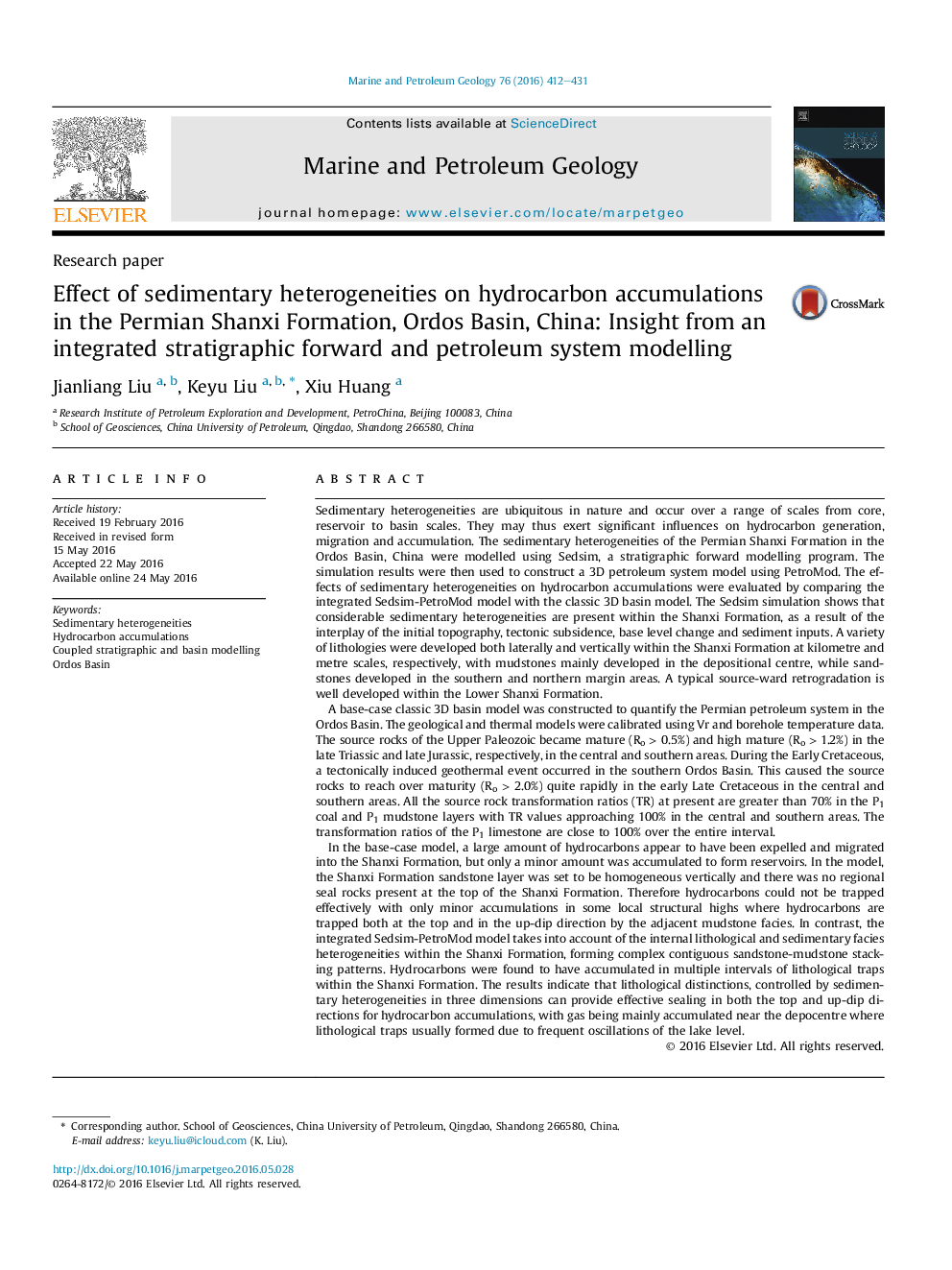| کد مقاله | کد نشریه | سال انتشار | مقاله انگلیسی | نسخه تمام متن |
|---|---|---|---|---|
| 6434757 | 1637151 | 2016 | 20 صفحه PDF | دانلود رایگان |
- Simulated the sedimentary evolution of the Shanxi Formation, Ordos Basin.
- Carried out coupled forward stratigraphic and basin modelling for the first time.
- Quantitative evaluate influences of sedimentary heterogeneities on hydrocarbon accumulations.
- May have significant implications for hydrocarbon exploration of lithostratigraphic reservoir types.
Sedimentary heterogeneities are ubiquitous in nature and occur over a range of scales from core, reservoir to basin scales. They may thus exert significant influences on hydrocarbon generation, migration and accumulation. The sedimentary heterogeneities of the Permian Shanxi Formation in the Ordos Basin, China were modelled using Sedsim, a stratigraphic forward modelling program. The simulation results were then used to construct a 3D petroleum system model using PetroMod. The effects of sedimentary heterogeneities on hydrocarbon accumulations were evaluated by comparing the integrated Sedsim-PetroMod model with the classic 3D basin model. The Sedsim simulation shows that considerable sedimentary heterogeneities are present within the Shanxi Formation, as a result of the interplay of the initial topography, tectonic subsidence, base level change and sediment inputs. A variety of lithologies were developed both laterally and vertically within the Shanxi Formation at kilometre and metre scales, respectively, with mudstones mainly developed in the depositional centre, while sandstones developed in the southern and northern margin areas. A typical source-ward retrogradation is well developed within the Lower Shanxi Formation.A base-case classic 3D basin model was constructed to quantify the Permian petroleum system in the Ordos Basin. The geological and thermal models were calibrated using Vr and borehole temperature data. The source rocks of the Upper Paleozoic became mature (Ro > 0.5%) and high mature (Ro > 1.2%) in the late Triassic and late Jurassic, respectively, in the central and southern areas. During the Early Cretaceous, a tectonically induced geothermal event occurred in the southern Ordos Basin. This caused the source rocks to reach over maturity (Ro > 2.0%) quite rapidly in the early Late Cretaceous in the central and southern areas. All the source rock transformation ratios (TR) at present are greater than 70% in the P1 coal and P1 mudstone layers with TR values approaching 100% in the central and southern areas. The transformation ratios of the P1 limestone are close to 100% over the entire interval.In the base-case model, a large amount of hydrocarbons appear to have been expelled and migrated into the Shanxi Formation, but only a minor amount was accumulated to form reservoirs. In the model, the Shanxi Formation sandstone layer was set to be homogeneous vertically and there was no regional seal rocks present at the top of the Shanxi Formation. Therefore hydrocarbons could not be trapped effectively with only minor accumulations in some local structural highs where hydrocarbons are trapped both at the top and in the up-dip direction by the adjacent mudstone facies. In contrast, the integrated Sedsim-PetroMod model takes into account of the internal lithological and sedimentary facies heterogeneities within the Shanxi Formation, forming complex contiguous sandstone-mudstone stacking patterns. Hydrocarbons were found to have accumulated in multiple intervals of lithological traps within the Shanxi Formation. The results indicate that lithological distinctions, controlled by sedimentary heterogeneities in three dimensions can provide effective sealing in both the top and up-dip directions for hydrocarbon accumulations, with gas being mainly accumulated near the depocentre where lithological traps usually formed due to frequent oscillations of the lake level.
Journal: Marine and Petroleum Geology - Volume 76, September 2016, Pages 412-431
